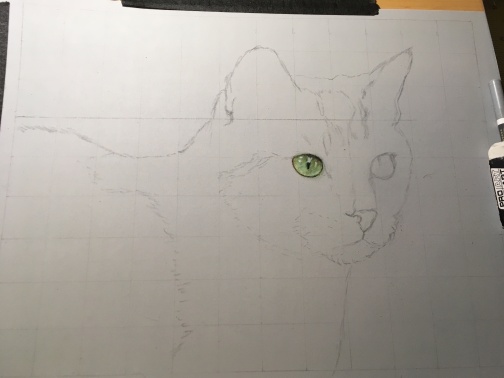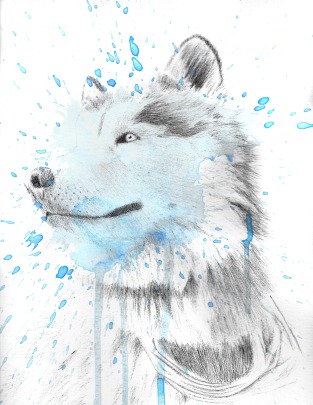Lately I’ve been taking a lot of work-in-progress photos and videos, to try and show how I work and the process I like to use (I’ll be posting some of that on here, but if you want more in depth blogs, follow me on Patreon). What this means is that people see all the little tricks and tools I use to get from a blank page to a finished piece. And one of my favourite tools is a bit of a controversial one: the grid.
Grids are a helpful tool that are used to break the drawing or painting into smaller chunks to improve accuracy. Basically you draw a grid on your page, and then place a grid of the same scale on your reference drawing. Now you know that the dog’s eye goes there, because in both your reference photo and your drawing it sits at the intersection of the third square down and the fourth across.

So what’s the problem with grids? Well, some people consider using grids to be ‘cheating’ (although the concept of cheating when making art is a bit of a strange one). Others think grids are simply a tool an artist can use to improve their accuracy and produce more realistic art. So where do I stand? Obviously I use grids, I’ve already said they’re one of my favourite tools.
But I do feel a little disappointed when I try and draw something freehand and then change to use a grid because I had so much difficulty. Somehow it feels like I’ve failed as an artist, because I had to use one of the tools in my arsenal. I’ve been thinking about that a lot lately, and it’s a bit silly.
If I tried to draw a straight line and failed, and then grabbed a ruler to draw a perfectly straight line, is that a failure? Is that wrong? I don’t think so. I use grids in the same way, so I don’t think I should feel any shame about it.
That being said, I don’t always use grids. In fact, I was thinking about it the other day and I actually very rarely use them, and I only use them in certain circumstances (though that number is increasing). I use grids for my pet portraits, and generally I only use them when the animal is at a strange angle (looking to the side, for example) or for dogs who have long snouts and big ears (eg. German shepherds). I’ve found in the past that I’ve spent hours on the base sketch in these cases, and have struggle to get the angle right, or to fit the dog into my frame. So now I skip that labour intensive step and just use the grid right off the bat, and it works great.

I also use grids to proof my sketch — recently I was working on a commission of a chihuahua and the sketch didn’t look quite right, so I drew a grid on top to check it. I was quite thrilled to see I was pretty much spot on, and went on to create quite a nice picture of the little guy.
So I use grids reasonably frequently when drawing people’s pet, but I have never used a grid when drawing wildlife. It took me a little thinking to figure out why. If you took my labrador retriever, who is a very typical yellow lab, and mixed him in with a bunch of other yellow labs, I would be able to pick him out. Very quickly, and probably from a reasonable distance.
The thing is, we know our pets’ faces. We know their bodies, we know their expressions. If you’ve paid me to draw your pet, chances are you treat them as part of your family, and know them well enough that you could look at a portrait and say ‘that’s my Fluffy!’, and not just a typical Yorkie. So accuracy is really important for me when I’m drawing pets. Accuracy matters, because owners can see the difference (or I assume they can).
But when I’m drawing wildlife, it doesn’t matter as much. If I make a lion’s nose a little too big or his ears too narrow, he is still a lion. Unless I make a major mistake, no one is going to question it. A lion is a lion is a lion. So I’ve never used a grid with wildlife portraits. I’ve never even thought about it. Accuracy in wildlife portraits is less important, because unless someone is looking at your reference photo and checking it against your work, no one is going be able to tell the difference. Drawing wildlife is great.

I still have a few things to say about grids, but this ramble has gone on long enough, so I’ll put them in a different post. For now, I have some art to do!

I would agree to using a grid when accuracy is key to the piece. I would think in portraiture for sure, and especially in a commission, though I have not done either. Another artist once told me to use the tools I have in my toolbox, using a grid, photos,
brushes, etc. I enjoy your art, and sharing the process is another great way to do that.
LikeLike
Thanks Jenny! I completely agree!
LikeLike